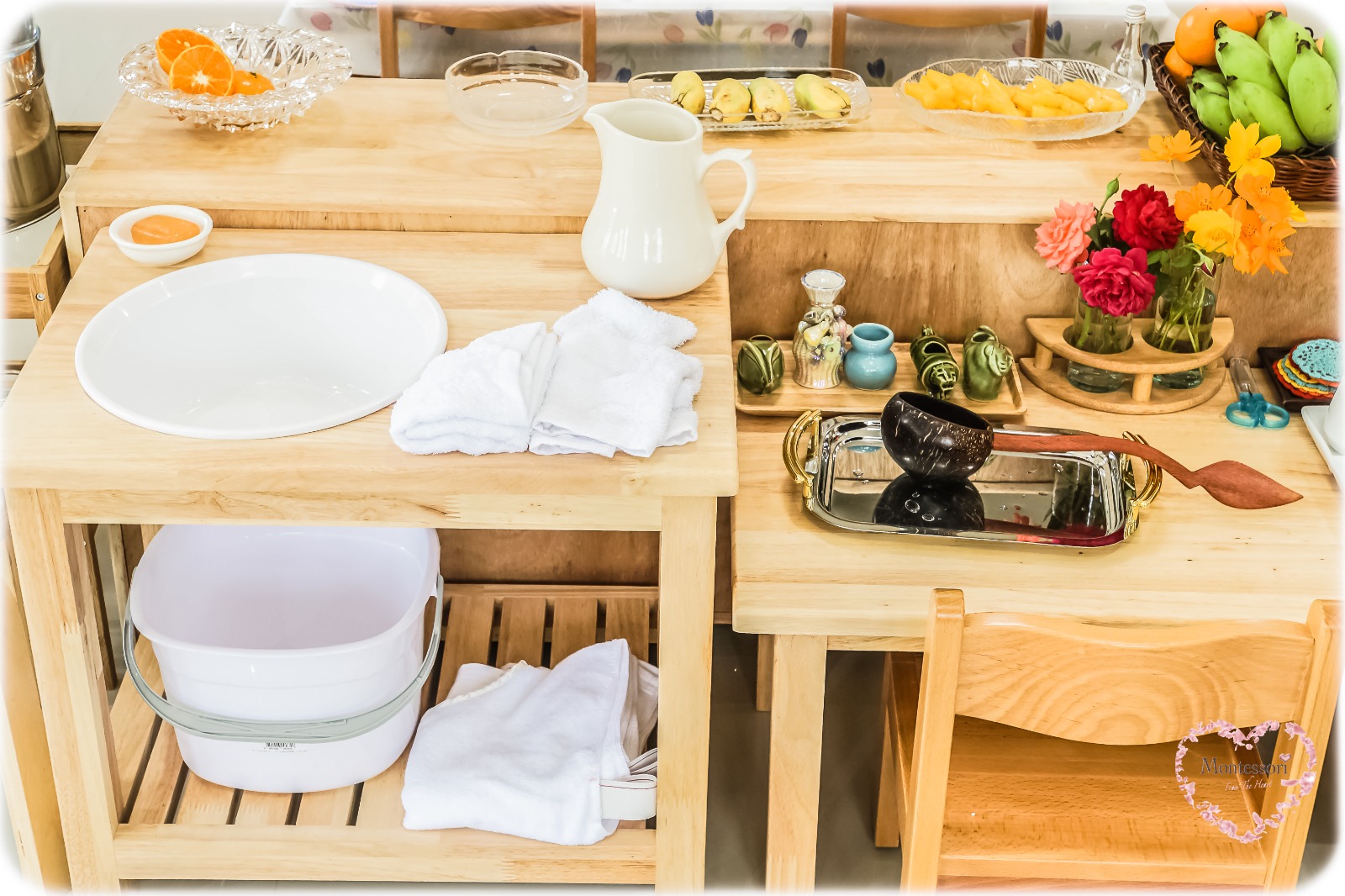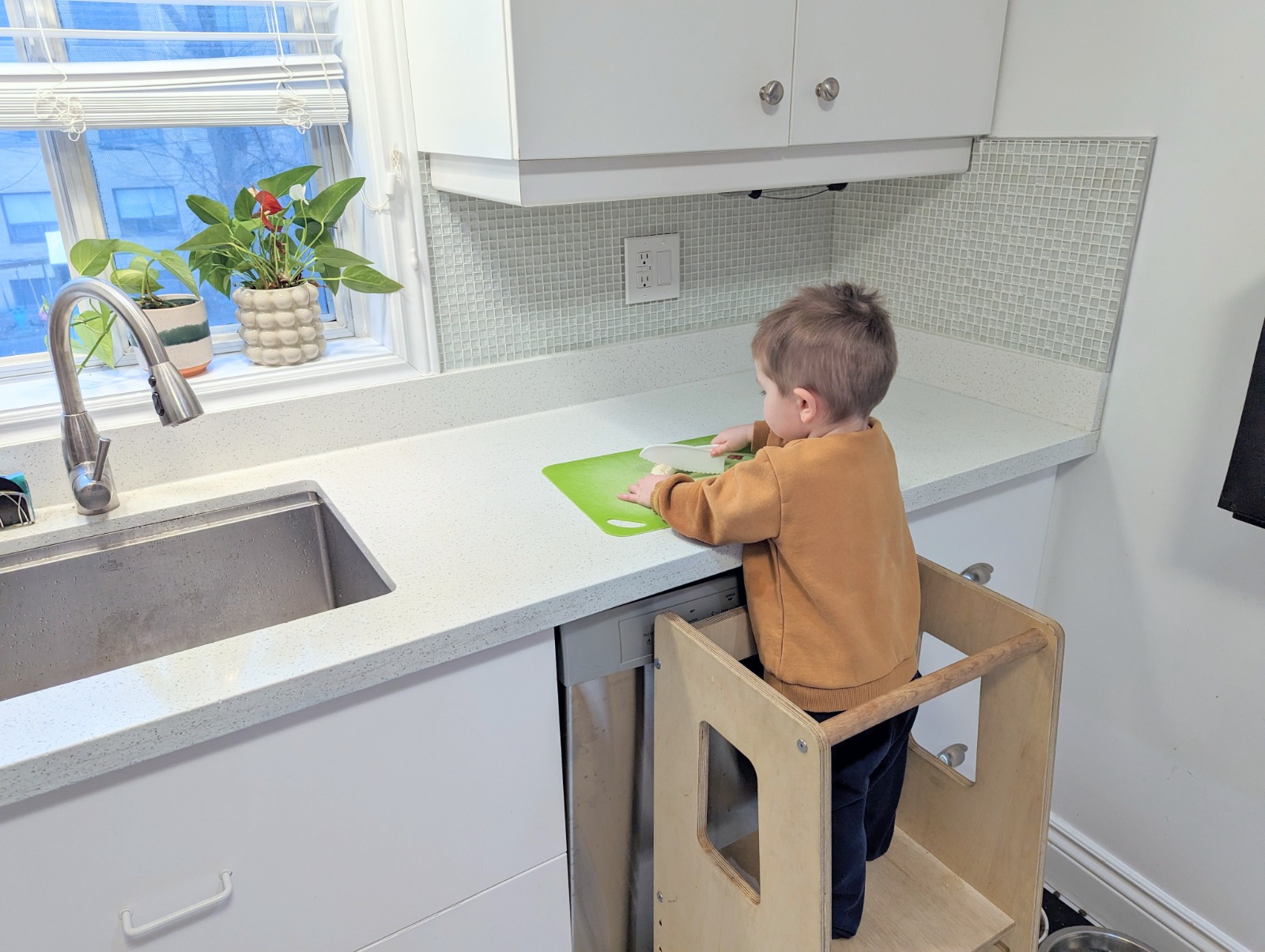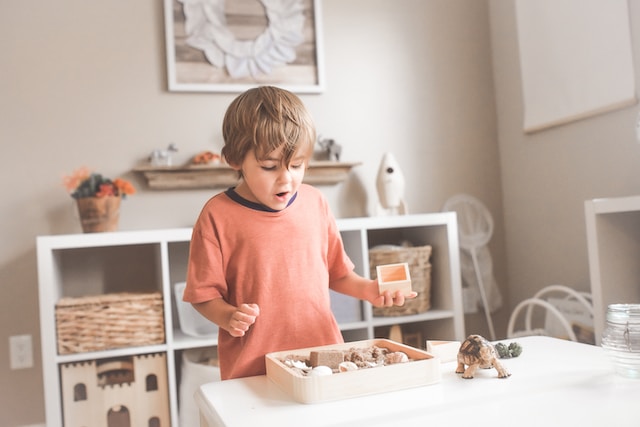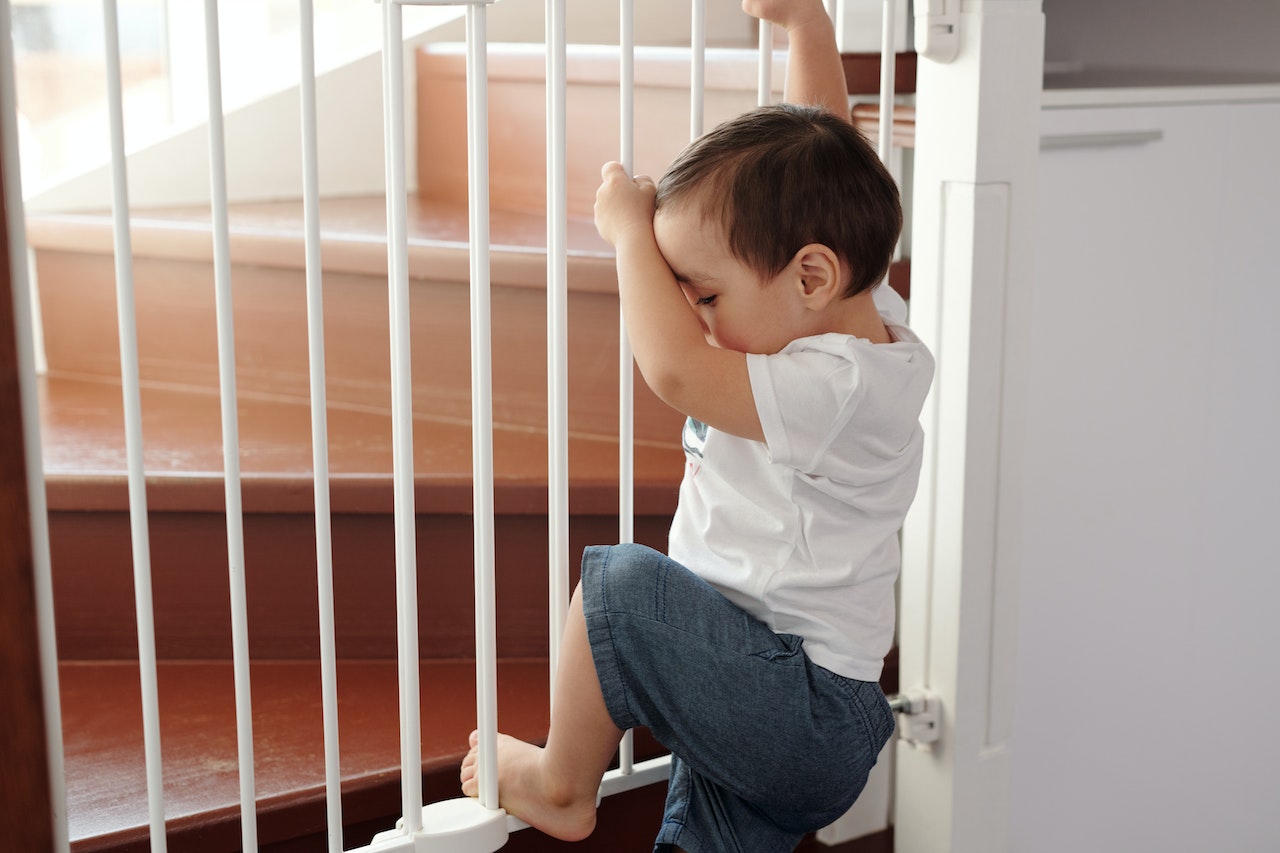The Montessori method is an educational philosophy and approach to teaching that emphasizes independence, freedom within limits, and hands-on learning. Developed in the early 1900s, the Montessori method is based on the idea that children learn best through practical, hands-on experiences and that learning should be self-directed and child-centered. Montessori classrooms are designed to be prepared environments conducive to learning and exploration. Children are encouraged to explore their environment, take on age-appropriate tasks, and learn through trial and error.
Adopting a Montessori lifestyle involves creating an environment that encourages exploration, independence, and learning through practical, hands-on experiences. To give you a better idea of how to start, we reached out to experts in the field for advice on how to adopt this way of living; read on to learn more.
What is the Montessori method?
“One would like to know in a few clear words what this Montessori Method really is.”
Dr. Maria Montessori from The Formation of Man, 1955 ed., p.7
The Montessori “Method” refers to research that Dr. Maria Montessori began conducting with preschool-aged children in 1907. In her research, she employed an approach that originated many years before with the research of two French physicians, Gaspard Itard and Eduard Seguin. This approach, called “scientific education,” was essential in observing children in their free, self-directed activity rather than teaching them according to a predetermined plan or curriculum.
With preschool-aged children, Montessori discovered that this approach led each child to a normal state of perfect harmony, peace, and order, which she later recognized as the child’s true nature. In time, Dr. Montessori’s use of scientific education became known worldwide as the “Montessori Method.”
As Dr. Montessori sought to describe her “Method” to others, however, she encountered obstacles due to a lack of clarity about the exact nature and function of scientific education, which she viewed as “something vague…the mere intuition or suggestion of a science…that…must emerge from the mist and clouds that have surrounded it.” (Montessori Method, p. 1-2). Within such a ‘mist and clouds”, the “Montessori Method” likewise remained vague and mysterious to practitioners and even Dr. Montessori herself.
“My method… I find this the most difficult subject of any on which to deliver a public lecture, for I have not evolved a method of ‘education.’”
Dr. Maria Montessori, from Education and Peace, pg. 76
“…For the word “Method” we should substitute something like this:…’ means offered to deliver the human personality from the age-old prejudices regarding education.”
Dr. Maria Montessori, from Formation of Man, p. 63
After Dr. Montessori died in 1952, the “Montessori Method” remains, for many, a subject of considerable conflict, confusion, and mystery as it varies from one personality, institution, or culture to another. In 1979, however, I resolved this mystery by discovering the exact nature and function of scientific education, and then later, a comprehensive technology for conducting this approach in an objective, reliable manner that was never possible before.
-Lee Havis at International Montessori Society
Is Montessori good for toddlers?
Absolutely! Montessori education has been around since the early 1900s, and it’s a methodology that has been proven to be successful time and time again. What sets Montessori apart from traditional education is that it’s designed to cultivate independence and self-motivation in children. Toddlers are at an age where they explore the world around them and discover new things every day. A Montessori education provides an environment where they can learn at their own pace and explore different subjects hands-only.
One of the most significant benefits of Montessori education for toddlers is that it encourages them to take ownership of their learning. Children are free to choose what activities they want to engage in, and they have opportunities to work independently or in groups. This approach fosters a sense of responsibility, self-discipline, and critical life success skills. Another essential aspect of Montessori education is that it’s designed to take advantage of the natural stages of a child’s development. Teachers work with children in small groups and tailor their curriculum to each child’s interests and abilities. This individualized approach ensures every child gets the attention they need to thrive.
Regarding social development, Montessori schools are also great for toddlers. Children are encouraged to interact with one another and to develop strong bonds with their classmates. They learn to communicate effectively and to work collaboratively with others, which are crucial skills for life. Overall, if you’re looking for an education prioritizing your child’s independence, creativity, and love of learning, then Montessori is an excellent option for your toddler.
And you can easily incorporate the Montessori way of learning at home with toys created to help your toddler develop their fine and gross motor skills while playing with their favorite toys.
I encourage every parent to adopt some parts of Montessori education.
-Linda at All About Baby Blog
What are some easy Montessori activities for Toddlers?
Introducing Montessori activities at home doesn’t have to be hard. The following activities are a great place to start – they’re fun, easy, and use materials you probably already have at home. Remember to always supervise your toddler during play, especially when exploring small objects.
Coin Box: Improve your toddler’s hand-eye coordination and fine motor skills with this simple activity. First, create a DIY coin box by cutting a slit into the lid of a large, empty container, like a recycled oats container or yogurt cup. Then provide coins or poker chips for your child to drop through the opening. For an easier variation, use an empty tissue box and colorful scarves.
Walk the Line: Create a path on the floor using masking tape, forming a straight line, circle, or zig-zag shape. Encourage your child to walk carefully along the path. To make the activity more challenging, have them balance an object, such as a bean bag or bell, while walking, or swap out the tape path for a low balance beam.
Pouring Water: Set out a cup, a small pitcher filled with water, and a sponge (for spills). Show your child how to pour water from the pitcher into the cup, cleaning up any spills as they go. Add food coloring to the water for a fun twist on this practical life activity.
Mystery Bag: Use a cloth drawstring bag and 3-5 familiar objects that your child can recognize by touch, like a key, hairbrush, or fork. Place items inside the bag, then ask your child to identify each object without peeking. Engage them with questions such as, “Where is the key? There it is! Now, where is the fork?”
Opening and Closing: Gather household items that open and close, like a coin purse, ring box, jar, or food storage container. Place them in a basket for your child to explore independently. For extra fun, hide a surprise inside each container.
-Meg at The Toddler Playbook
How can I live a Montessori lifestyle?
Living a Montessori lifestyle involves adopting the principles of Maria Montessori’s educational philosophy in your everyday life. One of the key aspects of this approach is fostering independence.
Encourage your child to become more self-sufficient by providing the tools for independence. Allow children to make their own choices about what they wear, even if what they choose may differ from what you would have picked for them. Allow them to be a part of the conversation when it comes to meals and meal planning as well.
Design a living space that is child-friendly, easy to navigate, and filled with items that are easily accessible to them—for example, place toys and other items of theirs on low shelves. Offer child-sized furniture so your child can participate in activities and do more things independently with greater ease.
The Montessori lifestyle includes a significant emphasis on practical life skills. Parents should encourage their children to take part in household chores, such as cooking, cleaning, and doing laundry. It is important to follow a child’s interests, as this helps to foster a love of learning. Learning is a lot easier when it is fun, after all! Encourage children to ask questions and learn about the world around them. An essential part of this is also being there to help them learn and answer their questions.
Showing respect for your child as an individual is very important. Teaching children to respect others’ feelings, thoughts, and opinions and communicating their thoughts and feelings respectfully is crucial and should be practiced equally by parents. You can help your child develop healthy relationships and a positive sense of self by emphasizing respect.
Living a Montessori lifestyle involves adopting a child-centered approach to daily life. By fostering independence, emphasizing practical life skills, and encouraging a love of learning, you can help your child thrive. We believe you can create a harmonious environment that promotes healthy relationships and personal growth that is better for you and your child!
What is the best age to start Montessori at home?

It’s never too early – nor too late, for that matter – to start Montessori at home and witness the profound benefits of this time-tested and transformational approach to raising confident, joyful, independent young people.
When they think of Montessori, most people picture child-sized furniture that first appeared in Montessori schools over a century ago and those gorgeous hands-on manipulatives that make learning concrete and active in Montessori classrooms worldwide.
At home, practicing Montessori means providing a low table and chair for young children to eat at or “work” next to a parent paying bills or answering emails or stepping stools that allow them access to adult-height tables, toilets, or basins. The aim is to encourage their independence safely, so floor beds and Stokke high chairs are popular in Montessori homes, rather than furniture that restrains or restricts the child’s freedom of movement.
Food prep tools designed for small hands allow young children to experience the thrill of cooking alongside a parent. And yes, with a bit of time invested in slowed-down training in peeling carrots or using an apple slicer, a three or four-year-old will surprise most adults in what they can do given the urge at this age to copy their parents and repeat skills that serve their own practical life needs!
More than appropriate tools and child-sized furniture, though, Montessori at home is more about a shift in attitude. Dr. Montessori used to say that anytime an adult does something for a child that they could do for themselves with a bit of training, they rob them of an opportunity to learn and become more independent – the hardwired goal of every child!
All humans are motivated fundamentally by the need to feel connected to and contribute meaningfully to family and community. When adults slow down their movements and expectations and come to see their own and their child’s mistakes – either academic or behavioral – as opportunities to learn, they can help their little ones become joyful lifelong learners even before they set foot in a classroom.
-Mark Powell at Montessori Australia
How can I create a Montessori-inspired Room?

Creating a Montessori-inspired room is a beautiful way to support your child’s development and foster a love of learning. Montessori is an educational approach that emphasizes independence, self-directed activity, and hands-on learning, and you can bring these principles into your home with a few simple steps.
First, it’s essential to create a space that is welcoming and inviting for your child. Choose colors and materials that are calming and soothing, such as natural wood, soft fabrics, and muted tones. Avoid bright, stimulating colors and patterns that can be overwhelming.
Next, consider the layout of the room. Montessori spaces are designed to be child-centered, with low shelves and furniture that allow your child to access materials and toys independently. Arrange the space so your child can move freely and explore without feeling restricted.
One of the critical elements of a Montessori-inspired room is the use of open-ended toys and materials that encourage exploration and creativity. This might include wooden blocks, puzzles, art supplies, and sensory bins filled with rice, beans, or sand. Choose toys made from natural materials with a simple design without flashing lights or loud noises.
Another critical aspect of a Montessori-inspired room is incorporating real-life activities and practical skills. This might include a child-sized kitchen or cooking area where your child can learn to prepare simple meals, a cleaning station where they can help with household chores or a gardening area where they can learn about plants and nature.
Finally, it’s important to remember that creating a Montessori-inspired room is more than just the physical space. It’s also about creating a mindset and approach to learning that values independence, exploration, and self-directed activity. Encourage your child to take ownership of their learning by allowing them to choose their activities and follow their interests. Celebrate their successes and offer support when they encounter challenges.
In creating a Montessori-inspired room, you are creating a space that supports your child’s natural curiosity and love of learning. You are fostering independence, creativity, and a sense of wonder in the world around them. Following these simple steps, you can create a space to inspire your child to explore, learn, and grow in a safe and nurturing environment.
-Anya Garcia at Montessori From The Heart
How can I make my kitchen Montessori?

A Montessori kitchen space is simply a kitchen that is accessible to the child. It’s designed to foster independence and support a child’s interest in kitchen activities.
There are four easy ways to do this:
- Set up a low cupboard with all your child’s utensils, dishware, and kitchen tools. This allows your child to set their place at the table, get a drink independently, or grab kitchen tools to help with meal prep.
- Related to the point above, set up a low cupboard or low fridge shelf with snacks that your child can access independently. You can limit what’s available by only putting a certain number of snacks in these spots each day.
- Add a Learning Tower. This is one of the most used items in Montessori homes. A Learning Tower (or a Montessori Kitchen Helper) is a step stool with a railing around the top, so it keeps your child safer and more contained.
This piece of furniture allows your child to stand independently at the counter and wash their hands, produce, or help with food prep. - Provide child-sized kitchen and cleaning tools. Adult tools are often too large for children to use effectively and can be frustrating. Child-sized tools, like toddler knives, whisks, or mashers, make it easy for children to participate in kitchen activities.
Why Set Up A Montessori Kitchen
Many activities adults consider chores, like cleaning and meal prep, are the exact kinds of activities that young children truly enjoy.
These types of activities are meaningful to them. They see the adults around them performing these skills and quickly understand the value of this type of work.
These activities also help to develop confidence and self-esteem as your child learns to do things for themselves and contribute to their home environment (“I am helping my parents, and that feels good!”).
So next time your child shows interest in helping you around the house, think about how to allow them to participate. Yes, it will be slower, but this is how they learn!
-Laura Berthiaume at The Montessori Room
What should I consider when choosing Montessori furniture?
Because there is no official standard for “Montessori Furniture,” it can be overwhelming for parents new to the philosophy. When choosing furniture, ask yourself, “does this promote learning, confidence, and independence.”
First, consider the accessibility and organization of shelves. Shelves should be the right height for children to access every shelf easily, be large enough to store materials uncluttered and be rotated regularly to keep the environment engaging. If the child is very young, opt for low fixed shelves sturdy enough to support them while learning to walk. You may consider adjustable shelves for more flexibility for preschool children and older.
Bookshelves should be front-facing, displaying book covers outward to encourage pre-reading children to make independent decisions about which books to read. This design encourages independence and decision-making skills and fosters a love for reading from an early age.
Quality tables and chairs are essential in a Montessori environment, as they are integral to children’s daily activities and learning experiences. The Montessori philosophy emphasizes child-sized furniture that allows children to move freely and independently, fostering a sense of autonomy and self-directed learning. Tables and chairs should be appropriately sized to accommodate children’s various activities, such as mealtimes, art, writing, and manipulative play.
Chairs should have a sturdy base, such as cube chairs or stools. Cube chairs are excellent for learning to dress and provide a stable seating option during weaning. Stools, conversely, make it easier for children to learn to sit down and get up from the table or activity area independently. Without the hindrance of a backrest, children can quickly maneuver themselves on and off the stool, promoting autonomy and self-reliance.
Incorporate a learning tower in the kitchen area to enable children to participate alongside adults. Children can use a learning tower to engage in age-appropriate tasks and help with simple meal preparation. Involving children in these activities from a young age fosters independence and introduces them to essential life skills such as cooking, cleaning, and organization.
While not traditionally Montessori, Pikler triangles have become very popular in Montessori environments. They support gross motor development, exploration, and self-directed play, aligning with the Montessori philosophy’s emphasis on self-autonomy and confidence.
Furniture aesthetics should prioritize simplicity and functionality, with clean lines, natural colors, and minimal ornamentation. Sustainability is also important, as choosing eco-friendly materials teaches children the value of caring for the planet. Consider furniture made out of FSC-certified, formaldehyde-free wood with non-toxic finishes. Investing in high-quality pieces may save money in the long run, as they will likely last longer, so consider your budget and purchase the best quality you can afford.
-John at RAD Children’s Furniture
What is the difference between Montessori toys and regular toys?
There are four key differences between Montessori and traditional toys.
The first, and the one we are most familiar with, is that Montessori toys are typically exclusively made of natural materials. Regular toys often have plastic pieces and require outside elements such as batteries to operate. In comparison, a Montessori toy will be made from wood (that’s us!), metal, cotton, or wool.
Secondly, a primary characteristic of Montessori toys is that they are rooted in reality. Instead of fantasy or made-up characters, they depict real-life animals, household objects, vehicles, etc..
The third difference is; each Montessori toy serves a specific educational purpose. Many regular toys will provide your kiddo with a few minutes of entertainment, and that’s about it. Montessori toys help your child further develop skills such as; language, math, gross and fine motor skills, arts and crafts, imagination, and so much more.
And finally, Montessori toys are simple. They don’t have a thousand bells and whistles, and they don’t make noise. However, they let your child calmly explore without overwhelming and overstimulating their minds and senses.
–Kathleen Smith at Smiling Tree Toys
What should I consider when choosing Montessori toys?
When it comes to purchasing Montessori toys, there are several things that parents and educators should consider. Here are just a few great tips from Nilo Toys that will help you pick suitable Montessori toys.
Toys should be easy to manipulate, especially for babies and toddlers still learning to grasp them. This means that they should have rounded edges and smooth surfaces. It is also essential to ensure the toys are not chunky or small enough for choking hazards, as children are often prone to swallowing objects.
Choosing toys that can be taken apart and reassembled is another crucial aspect of selecting Montessori-friendly toys. This includes exciting blocks, some puzzles, and other toys that allow children to practice fine motor skills, hand-eye coordination, and problem-solving abilities. Nilo Toys offers Lego baseplates that fit small and large building blocks for kids, plus they’re double-sided, so you can get twice the use!
Avoid toys with too many bells and whistles, as they can distract your child from concentration and problem-solving. They should also not be battery-operated, which can break a child’s concentration and stifle creativity at this stage.
Additionally, the best way to keep your child’s playroom organized is to stick to a minimal approach to toy presentation. This will encourage your child to spend more time focused on their own exploration and less distracted by the appearance of other toys. This will also allow your child to have more independent play and develop their own creative solutions for problems that arise in their play.
Play tables act as the perfect centerpiece for play, plus storage solutions that can help clean up all the clutter and keep the toys from ending up all over the ground. You should look at Nilo Toys for an activity table or toy storage solutions. Don’t forget you can use the play table & storage solutions to teach organization and skills that will last a lifetime!
-Connor Ernst at Nilo Toys
What is the purpose of Montessori education?
The purpose of Montessori education is to be a help to life. Just as we can observe the natural growth in a flower—from sprout to seedling, to plant, to flower, to seed—we can also observe children’s natural and normal development. In Montessori education, we refer to this natural and normal development process as “normalization.”
To help life, we support this process of normalization for children. Our teaching and learning principles derive from what we have observed and learned about this fundamental normalization process.
For all of our lives, there are four main signs of normalization that we can begin to observe even in infants:
- Love of work or activity.
- Spontaneous development of deep concentration.
- Spontaneous self-discipline.
- Sociability seen as joyful work and cooperation.
There are other signs of normalization in the young child, but these four are observable at all points of human development.
The main sign of on-track development is joyful work.
Work, in Montessori terms, refers to a child’s self-selected activity with an observable beginning, middle, and end.
For example, table washing is one activity in a Montessori early childhood environment. All the materials needed to wash a table are on a shelf. The child selects the table washing materials, sets up the activity, washes the table to their satisfaction, then returns the materials to the shelf, ready for the next person.
In Montessori environments, we support the child’s development by offering a wide variety of activities for the child to freely choose and do, allowing the child to tap into a natural cycle of activity, which we call a work cycle. This work cycle helps the child stay on the path of normalization.
As Montessori educators, we aim to help life by supporting normalization, the normal and natural process of human development.
-Maren Schmidt at Maren Schmidt
How is Montessori different from regular schooling?
Montessori homeschooling is an excellent alternative to traditional schooling, allowing kids to learn at their own pace and in their way. This child-led approach to education emphasizes independence, creativity, and practical life skills, giving kids a unique and fulfilling learning experience.
Dr. Maria Montessori, a renowned educator, developed the Montessori Method in the early 1900s. This teaching approach is child-centered, using child-led activities known as “work.”
According to Dr. Montessori, children learn better when they have a say in what they learn. Unlike traditional classrooms, Montessori can access different activity stations throughout the day. The grading system in a Montessori homeschool is also nontraditional, focusing on developing the whole student, including their social, emotional, intellectual, and physical well-being.
One of the key differences between Montessori homeschooling and traditional schooling is the emphasis on practical life skills. In Montessori, children are encouraged to learn skills like cooking, cleaning, and gardening, which can help them build important life skills and increase their independence. You don’t usually learn that in traditional schools; they prioritize academics over real-life skills.
Unlike traditional schooling, which often follows a strict curriculum and schedule, Montessori allows children to explore their interests and learn naturally and organically at their personal pace. This organic and personalized approach keeps kids engaged and highly motivated, and many kids thrive, especially those who may struggle with the rigid structure of traditional schooling.
Also, Montessori homeschooling emphasizes working together and social skills, which can be valuable for children navigating the world around them. Traditional schooling focuses more on individual achievement and test scores, which can lead to a competitive and potentially isolating learning environment.
Montessori homeschooling offers a refreshing alternative to traditional schooling, providing kids with a unique and personalized learning experience that promotes independence, creativity, and practical life skills. If you’re looking for an educational approach that prioritizes your child’s individual needs and interests, Montessori homeschooling may be the perfect fit.
-Forest Rose at Kingdom First Homeschool
Can I teach Montessori at home?
Incorporating Montessori techniques into your home is a great way to teach your child to become more independent, forward-thinking, and collaborative. That is because the Montessori Method is all about letting the child lead – they guide themselves through their curiosities and interests. To do this in your own home, set up different “stations” or areas in your child’s play space so that they can be free to explore.
These are some examples of stations you can set up: A kitchen play area where they can play chef or restaurant, a block or sensory bin area where they can explore touch and building, an arts & crafts area where they can be creative, a dress-up area where they can play pretend, and a quiet area where they can read or be read to. Plus, access to outdoor play and physical activity is one of the cornerstones of Montessori teaching. Make sure your child can spend time outside (safely and supervised) so they can explore nature and move their body.
The goal is to let your child direct their learning and follow their own curiosities. You are there as scaffolding – you can answer questions and help them dive deeper into their pretend play and games – but let them lead.
The best part about using Montessori techniques at home is that it does not feel like teaching. Unless you homeschool your child, spending time at home should be primarily about fun and relaxation. Children learn in daycare and school all day and want to feel like they can play at home. Incorporating a Montessori mindset at home means that your child can continue gaining the benefits of this learning style without feeling like school is continuing when they are at home. Instead, they are just free to explore their interests and increase their independence while they do it.
-Lizzie Kreitman at Sawyer
How do you plan a Montessori curriculum?
Planning for a Montessori curriculum depends on the age and stage of the child. Montessori education is divided into three-year groupings: 0-3 years, 3-6 years, 6-9 years, 9-12 years, 12-15 years, and finally, 15-18 years. Each of those ages requires different experiences and curricula for children. The one commonality for each age group is we must follow the child.
To plan for Infants and Toddlers, one must consider movement and language development, much experiential learning, and strong caregiver relationships. Spaces should be safe for infants and toddlers to move freely and be able to access toys themselves. Montessori educators do not use equipment that puts children in positions they are not ready for, such as highchairs, exersaucers, walkers, etc. We believe that children should develop naturally; therefore, we feed children by holding them until they can sit in a small chair, we hold their bottles until they can hold them, and we provide pull-up bars and equipment to encourage the development of the movement. We speak to them, sing to them, and are respectful in all possible ways. The “toys” used at this age are made of wood or nontoxic and natural materials. The toys are placed on a shelf on the floor where the children may access them freely.
As the toddler becomes a preschooler, we provide slightly larger tables and chairs. We work on different skills with different materials. We teach daily living skills like how to put on shoes, coats, and clothes. We work to help the child become independent by allowing children to do things for themselves. We teach children how to do something and then allow them to try it. This is called a presentation. Children ages 3-6 are very interested in learning new words, helping with adult chores, refining motor skills, and learning through their senses. They should be allowed freedom of movement as their bodies develop as much as their minds. They should spend time outside, as they are often connected to the natural world. Inside the house, they should be able to get themselves a snack or a drink from a low shelf. They can help fold laundry or unload the dishwasher. They need purposeful activities to feel purposeful and build themselves, which is considered the child’s work. We believe the process is more important than the product at this age.
As the preschoolers enter elementary and on to secondary education, there is a semi-prescribed curriculum that again follows the child’s physical, social-emotional, and cognitive needs. Montessori education is academically rigorous but also engaging, creative, and inspiring. It is based on experiential learning that is age and stage appropriate.
-Shanna Honan at Chesapeake Montessori School
What are the principles of Montessori materials?
We hear a lot of talk about the Montessori materials, but what exactly are those materials? How do we determine if something “qualifies” as Montessori or not? There is actually a list of characteristics that must be considered when creating Montessori material. Dr. Montessori developed this list because she knew that science was constantly advancing. The materials she developed in the early 1900s needed to evolve as our understanding of the world and human development grew.
The student’s ages and abilities are at the top of her list (from birth to dementia care). All materials must be sized to match the size of the humans they are designed to teach and also be matched to the capacities of those humans. So, the materials will necessarily differ when used to teach young children compared to adolescents or adults.
Beyond that core, the material should have most if not all of the following attributes. They:
- Are self-teaching (auto-didactic).
- Have a build in control of error (so students can correct their mistakes).
- Have intelligent/intended uses.
- Require movement.
- Isolate a stimulus.
- Refine the senses.
- Include vocabulary.
- Create a materialized abstraction.
- They are aesthetically appealing.
- Provide indirect preparation for future work/studies.
- Allow for repetition.
- Have diagnostic value.
- Encourage memory training.
The materials in an authentic Montessori school have been designed with these characteristics in mind. Each material might not contain every characteristic, but they will embody many if not most of them. The key here is that the materials meet the innate needs of human development, no matter the student’s age.
We’ve written a blog post about this if you’d like to read more about what each of these means and how it looks in real life. Just remember that because we are supporting learning/neurodevelopment, the tiny details matter.
-Julia Volkman at Maitri Learning
How do you organize Montessori language materials?
When it comes to language, every conversation is a rich opportunity for teaching listening and speaking skills to children. As for reading and writing skills, the organization is an important first step to creating a learning environment for children to learn at their pace. In Montessori philosophy, this concept is called the “prepared environment.”
The first step is to declutter the area and designate an open shelf or part of the room for language materials. Shelves, trays, and baskets are commonly used to organize language materials. In addition, a small rug (“work mat”) or child-sized table is nearby for the child to enjoy the literacy activities.
Each activity has a designated tray or basket on a shelf to help children know where to find and return language materials. For example, pre-reading activities, such as picture and letter matching, can be in one basket, while pre-writing activities, such as salt or sand-writing, would be in a separate tray. Children can then carry these portable trays and baskets to their rug or table to work on the activity.
For families teaching their children a second language, consider focusing on the minority language and prioritizing activities in that language, for those who prefer to introduce literacy in both languages simultaneously, separate and organize the materials on different shelves or at least different sections of a rack.
As for books, one of the most critical language materials, displaying the front covers of the books, such as on a wall shelf or ledge, makes them noticeable and enticing. If space and budget are limited, consider a unique book basket on the ground for children to quickly explore, take, and put back.
Following these steps, you can create a prepared environment supporting the child’s language development while promoting autonomy, organization, and concentration.
-Betty at Chalk Academy
How can you incorporate Montessori techniques into your teaching style?
The Montessori philosophy incorporates hands-on activities in sequences from simple to abstract across the curriculum “avenues” of practical life, sensorial, language, and math. Many of the materials are specific to an early childhood classroom. They can be purchased from a Montessori company, while others can be made or put together using everyday items found around your home.
The practical life curriculum introduces children to pouring water (wet transfer), spooning (dry transfer), folding, sewing, and plant shining. More complex and multi-step activities include hand washing, orange juice squeezing, and arranging flowers. The activities not only familiarize students with everyday activities but also strengthen the hand and focus on fine motor skills that prepare them for writing.
The sensorial curriculum is a series of materials that bring attention to various objects’ size, shape, weight, texture, sound, and visual discrimination. These lessons can lead to introductory geometry, botany, music, and geography concepts.
You can create a rich and exciting sequence of language lessons that start with vocabulary and then lead into the alphabetic principle and phonemic awareness to prepare the child for reading and writing. Sandpaper letter cards are used, so students have a tactile understanding of the formation of letters. Many language materials can be made at home or school using heavy cardstock paper and laminating the finished product to be used for many years.
Math materials are very interactive with physical counting and moving quantities of objects from one place to another, such as work with the numerical rods. Introducing the quantity than the number symbol are the appropriate steps to learning numeration 1-10, linear counting, the decimal system, and more abstract lessons. Telling time, word problems, and fractions round out the most advanced lessons in the math curriculum.
Beyond the four main curriculum avenues, Montessori also brings peace education, grace & courtesy lessons, movement, science, art, and cultural subjects to the classroom. By incorporating Montessori principles and lessons into your teaching, students will be engaged and enjoy the learning process!
-Karen Walton at Age of Montessori
How do I teach my child to help with chores?
Here are three Montessori principles you can adopt to shift the family dynamic and get kids to take on responsibilities at home.
Start with Teaching Self-Care.
Helpless infants need an adult to care for their essential needs, so new parents quickly become accustomed to expressing love and care by doing things “for” their child. Whether it’s due to cultural norms, a lack of understanding of child development, or just a desire to get out the door in the morning efficiently, many parents continue to feed, dress, and clean up after their children long after it’s necessary. This sets up a “learned helplessness” dynamic that is hard to reverse when the parent later decides it’s time for a child to become more independent and help out around the house. So Tip #1 is to Start Early when your child is a preschooler. Rather than making the assumption your young child still needs assistance, make time to observe your child at regular intervals and notice what skills have been gained over time. Once you’ve assessed what your child is capable of or interested in doing, teach how to complete all parts of a task. Learning to brush teeth, for example, should include learning to wipe the sink clean afterward and putting away the toothbrush and toothpaste. Slowly model the steps of completing a task without talking. Your silence and deliberate movements will intrigue the child and focus his or her attention on the sequence of steps. Transitioning a child to doing self-care tasks independently as soon as they are ready to do so builds the child’s confidence and self-esteem. It also establishes early on the norm that each family member does what he or she can to make household routines run smoothly.
Prepare the Environment.
Most Montessori classrooms have an “invisible teacher,” which is the classroom itself. The learning environment is set up in ways that inspire children to engage with materials and make it easy to keep them organized. You can do this at home with bins, baskets, and other color-coded containers to indicate what gets stored in them. Place child-sized cleaning tools (broom, dustpan/brush, spray bottle of water, clean rag) where they can reach them. Once the space is set up to work well, set aside time to do chores with your child. Children can be easily overwhelmed by tasks like “tidying up the playroom,” so doing it together and making it fun is an excellent way to introduce new responsibilities. After that, try breaking big jobs into mini-tasks and setting a timer to make it a game: “Let’s see whether you can put all the Legos in this bin in 3 minutes!” The key is to have an identified spot for everything so the process doesn’t get derailed by confusion about what to do with a particular item.
Be patient.
Any executive will tell you it’s usually easier to do a job yourself than delegate it. The same is true when you start trying to have kids take on household responsibilities. Let’s face it: they won’t do it as well as you would. However, nothing kills motivation more than having someone criticize or redo your work. So back off! When the child attempts the task, try not to interfere immediately, even if the child struggles. Offer cues when needed, but avoid jumping in to do the job yourself, especially if the child is eager to assume responsibility. Follow Maria Montessori’s maxim: “Never help a child with a task at which he feels he can succeed.”
-Beth Black at Wellan Montessori School
Remember that adopting a montessori lifestyle is not about creating a perfect environment or adhering to a strict set of rules. Instead, it’s about creating a lifestyle that fosters learning, independence, and exploration, and allows your child to develop at their own pace.




